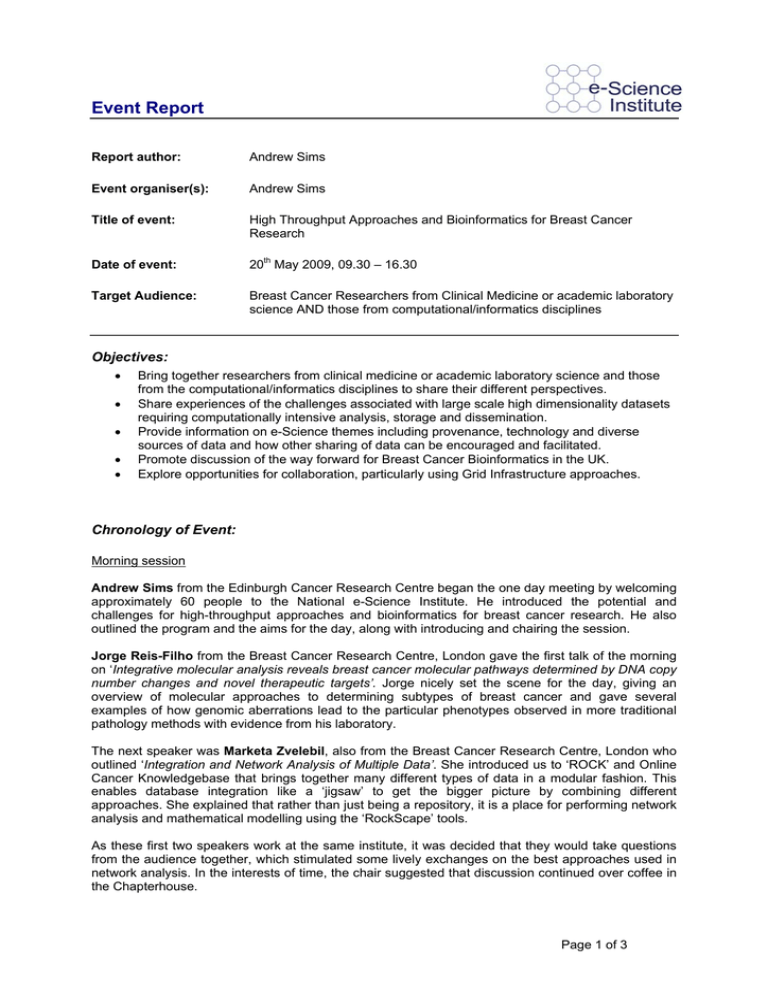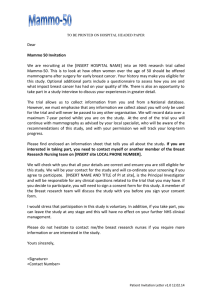Event Report
advertisement

Event Report Report author: Andrew Sims Event organiser(s): Andrew Sims Title of event: High Throughput Approaches and Bioinformatics for Breast Cancer Research Date of event: 20th May 2009, 09.30 – 16.30 Target Audience: Breast Cancer Researchers from Clinical Medicine or academic laboratory science AND those from computational/informatics disciplines Objectives: • • • • • Bring together researchers from clinical medicine or academic laboratory science and those from the computational/informatics disciplines to share their different perspectives. Share experiences of the challenges associated with large scale high dimensionality datasets requiring computationally intensive analysis, storage and dissemination. Provide information on e-Science themes including provenance, technology and diverse sources of data and how other sharing of data can be encouraged and facilitated. Promote discussion of the way forward for Breast Cancer Bioinformatics in the UK. Explore opportunities for collaboration, particularly using Grid Infrastructure approaches. Chronology of Event: Morning session Andrew Sims from the Edinburgh Cancer Research Centre began the one day meeting by welcoming approximately 60 people to the National e-Science Institute. He introduced the potential and challenges for high-throughput approaches and bioinformatics for breast cancer research. He also outlined the program and the aims for the day, along with introducing and chairing the session. Jorge Reis-Filho from the Breast Cancer Research Centre, London gave the first talk of the morning on ‘Integrative molecular analysis reveals breast cancer molecular pathways determined by DNA copy number changes and novel therapeutic targets’. Jorge nicely set the scene for the day, giving an overview of molecular approaches to determining subtypes of breast cancer and gave several examples of how genomic aberrations lead to the particular phenotypes observed in more traditional pathology methods with evidence from his laboratory. The next speaker was Marketa Zvelebil, also from the Breast Cancer Research Centre, London who outlined ‘Integration and Network Analysis of Multiple Data’. She introduced us to ‘ROCK’ and Online Cancer Knowledgebase that brings together many different types of data in a modular fashion. This enables database integration like a ‘jigsaw’ to get the bigger picture by combining different approaches. She explained that rather than just being a repository, it is a place for performing network analysis and mathematical modelling using the ‘RockScape’ tools. As these first two speakers work at the same institute, it was decided that they would take questions from the audience together, which stimulated some lively exchanges on the best approaches used in network analysis. In the interests of time, the chair suggested that discussion continued over coffee in the Chapterhouse. Page 1 of 3 After the quick break, Carlos Caldas from the Cambridge Research Centre got things going again with a talk entitled ‘Bioinformatics analysing of breast cancer genomes’. After discussing some previous work looking at approaches to molecular classification of breast tumours, Carlos unveiled some very preliminary data from the METABRIC (molecular taxonomy of breast cancer international Anglo-Canadian collaboration consortium). This comprehensive study with over 2000 cases includes aCGH, miRNA, mRNA and methylation data, has much greater statistical power which will identify and characterise rarer types of breast cancer. Chad Creighton from the Baylor College of Medicine in Houston, Texas gave a talk from the perspective of ‘Gene transcription signatures of oncogenic pathways in breast cancer’. By combining experimental models such as cell lines, xenografts and genetically altered mouse models with primary tumour data, Chad showed how improved knowledge of oncogenic pathways can be used infer the causes of treatment resistance and potential strategies to overcome this. Running a little late from the program, we enjoyed an excellent lunch. Afternoon Session John Bartlett from the Edinburgh cancer Research Centre chaired the afternoon sessions, first introducing, Florian Markowetz from the Cambridge Research Centre, who described ‘Probabilistic graphical models in breast cancer genetics and genomics’. Florian has only recently started at the Cambridge Research Centre and is attempting to bring the concepts of pathway module networks from research on yeast to the field of breast cancer; he outlined some of the potential challenges and opportunities for this approach. Ekaterini Blaveri represented the NCRI Informatics Initiative at the meeting and explained how ‘The NCRI ONcology Information eXchange’ (or ONIX for short) can facilitate the transfer of information between collaborators. The initiative also tries to encourage a cultural change of data sharing and adoption of standards that will improve meta-analysis. She described the Grid infrastructure and development of Semantic services and the timeline for their deployment. The next talk was a something of a ‘double-act’ by Dimitrios Kalaitzopoulos from one of the event sponsors InforSense and Anita Grigoriadis from the Kings Breakthrough Research Unit. The title of their talk was ‘Integration of clinical and experimental data from disparate sources to facilitate highthroughput bioinformatics’. Following some company background and an explanation of how the integrative tools in the InforSense program enables interface functionality and ‘visual programming’, Dimitrios gave a case study of its use at the Dana Faber Institute in Boston (in collaboration with John Quackenbush – who was unable to attend the meeting). Anita then gave the perspectives of using Inforsense in a pilot project at the Kings Breakthrough Unit, comparing it to a Rubik's Cube in the way it is possible to combine different types of data with many analysis approaches. She described how the workflows generated could be re-used allowing lab scientists to mine datasets themselves, rather than relying on Bioinformaticians. The questions and discussion that followed these talks centred on how hard it would be to take the pilot project to the next level to include large amounts of clinical data. After over-running in the morning, this session finished a little early, although this provided more time for further discussion and viewing of the posters over tea and chocolate cake. Emanuele de Rinaldis from IRBM MERCK MRL in Rome gave a novel perspective in his talk on ‘Comparative expression pathway analysis of human and canine mammary tumours’. This was the first transcriptional study of breast cancer in dogs. Comparing human and dog tumours showed remarkable overlap, offering the potential to identify new biomarkers or perform clinical trials, which have begun in a Europe-wide imitative. The audience was surprised to hear just how prevalent spontaneous breast tumours are in dogs. One of the questions highlighted that as some breeds of dogs are more susceptible than others they may be opportunities to identify conserved genetic predisposition in humans. David Harrison from the Edinburgh Cancer Research Centre gave the final talk of the day on ‘Systems pathology tools for breast cancer research’. He gave a frank assessment of where current pathology methods are helpful (diagnosis, prognosis and heterogeneity) and useless (signalling Page 2 of 3 pathways, prediction and metabolomics). David highlighted the fact that Breast Cancer is not a static, but a dynamic disease and that to really understand tumours we need to look study their behaviour. Using reverse phase protein arrays to characterise the phospho-proteome had enabled models and networks to be generated that were capable of robust predictions and generating new hypotheses. Event Achievements: The event was considered by all to be a great success, with many favourable comments about the organisation of the event, high calibre of the speakers and the variety of the content. The first presentation of exciting new data from a large multinational clinical trial contrasted with smaller scale but novel approaches to learn more about breast cancer by studying the disease in dogs or using ordinary differential equations to model complex signalling pathways. There were some useful discussions on the increasing challenges for analysing and integrating diverse data sources and the possibilities for wider collaboration and data sharing. New approaches, initiatives and possibilities were outlined for making the most of the data in order to bring meaning to the complexity of breast cancer. Discussion during the breaks was very lively, in fact it was quite a challenge to curtail some of the many conversations and get the participants back into the lecture theatre! Participants representing the informatics groups at the three Breakthrough-funded units agreed that they would arrange a meeting in London within the next couple of months to more clearly define their research areas, to prevent replication of effort and work out how they could support each other more on specific projects. Efforts would also be made to establish whether the pilot InforSense project could be accessed by the other Breakthrough Units. It was agreed that researchers needed to make the case to Breakthrough to increase their funding in the area breast cancer bioinformatics. Possibilities such as a new post at each of the units with the remit to work on collaborative projects across the UK could be explored. The success and number of people attending the meeting may well help to strengthen the case for more funding. All of the speakers thanked the host for the opportunity to speak at the meeting. Many of the participants commented that they would be very interested in attending a similar event in the future. Any Other Observations: The e-Science Institute Staff were very helpful, friendly and accommodating. Minor suggested improvements were that a working laser pointer (green rather than red?) would have been useful and coffee before the meeting began, as some people arrived early. A couple of people struggled to find the venue, due in part to the website being down the day before the event. Page 3 of 3



